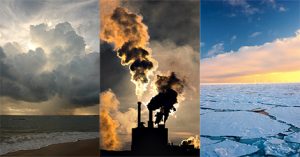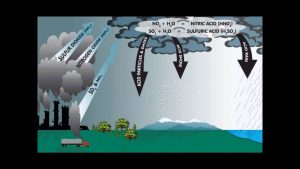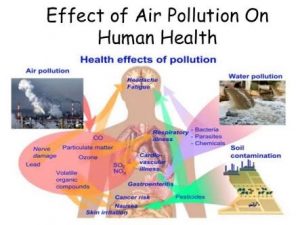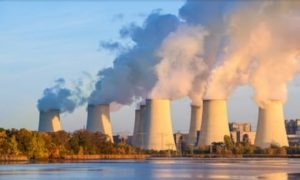Global Warming – Effects, Prevention, An Over View
Global warming
Global warming is occurring when carbon dioxide (CO2) and other air pollutants collect in the atmosphere and absorb sunlight or solar radiation that have bounced off the earth’s surface. Normally this radiation would escape into the space, but these pollutants, which can be last for years to the centuries in the atmosphere, trap the heat and cause the planet to get hotter. These heat-trapping pollutants specifically carbon dioxide, methane, nitrous oxide, water vapor, and synthetic fluorinated gases are known as greenhouse gases, and their impact is called the Greenhouse Effects. Global Warming is the rise in average temperatures of across the globe, which has been ongoing at least since record keeping began in 1880.
Although people tend to use these terms interchangeably, global warming is just one aspect of climate changes. “Global warming” refers to the rise in global temperatures due to mainly, the increasing concentrations of greenhouse gases in the atmosphere.
One of the most dramatic effects of the global warming is the reduction in Arctic sea ice. Sea ice hit records-low extents in both the fall and winter of 2015 and 2016, meaning that at the time when the ice is supposed to be at its peak, it was lagging. The melt means there is less thick sea ice that persists for multiple years. That means the less heat is reflected back into the atmosphere, by the shiny surface of the ice and more is absorbed by the comparatively darker ocean, creating a feedback loop that causes even more melt, according to NASA’s Ice Bridges.
Impacts of Global Warming
Each year scientists learn more about the Consequence of Global Warming, and each year we also gain new evidence of its devastating impact on people and the planet. As the heat waves, droughts, and floods associated with climate change become more frequent and more intense, communities suffer and death tolls rise. Normally the radiations would escape into space, but these pollutants, which can last for years to the centuries in the atmosphere, trap the heat and cause the planet to get hotter.
Other Effects of Global Warming
- Disappearing Glacier, early snowmelt, and severe droughts will cause more dramatic water shortages and continue to increase the risk of wildfires in the American West.
- Rising Sea Level will lead to even more coastal flooding on the Eastern Seaboard, especially in Florida, and in other areas such as the Gulf of Mexico.
- Forests, farms, and cities will face troublesome new posts, heat waves, heavy downpours, and increased flooding. All of these can damage or destroy agriculture and fisheries.
- Disruption of habitats such as coral reefs and alpine meadows could drive many plant and animal species to extinction.
- Allergies, asthma, and infectious disease outbreaks will become more common due to increase the growth of pollen-producing ragweed, higher levels of air pollution, and the spread of conditions favorable to pathogens and mosquitoes.
Causes of Global Warming
- Oil and Gas – Oil and Gas is used all the time in almost every industry.
- Deforestation. Deforestation is the clearance of woodland and forest-this is either done for the wood.
- Power Plants
- Oil Drilling
- Transport and Vehicles
- Consumerism
Prevention
- Limiting the amounts of energy in your home by using energy efficient light bulbs and appliances, and knowing how to use the appliances properly.
- Use an air conditioner and heater only when necessary, and make sure your house is properly insulated.
- Use a hot water sparingly and use cold water when washing clothes and dishes.
- Reduce the driving and use other means of transportation like walking, biking or carpooling.
- Recycle and use reusable bags for purchases and use the refillable water bottles.
Clean Our Air
Clean Our Air
Since air pollution is damaging to the environment and human health, we all need to play our part in reducing the level of air pollution in our neighborhoods.
The scientific evidences of disturbing links between the air pollution and health continues to build. In accordance with recent WHO estimates, exposure to the air pollution is the more important risk factors for major non-communicable diseases than previously thought. Air pollution is the largest contributor to the burden of disease from the environment. Air pollution can cause and exacerbates a number of diseases, ranging from asthma to cancer, pulmonary illnesses and heart disease.
Clean Air Act
Experience with the Clean Air Act since 1970 has been that protecting public health and building the economy can go hand in hand. Clean Air Act programs have lowered levels of six common pollutants — particles, ozone, lead, carbon monoxide, nitrogen dioxide and sulfur dioxide — as well as numerous toxic pollutants.
Air quality improvements has enabled many areas of the country to meet national air quality standards set to protect public health and the environment.
State emission control measures to implement the Act, as well as EPA’s national emissions standards, have contributed to air quality improvements.
Air pollution and the Environment
Increased ground-level ozone also causes damage to cell mem – branes on plants, inhibiting key processes required for growth and development. The loss of plant cover affects us all. Trees and other vegetation absorb pollutants such as excessive nitrogen dioxide, ozone and the particulate matter, through their leaves and needles and thereby help improve air quality. Less plant cover, this means less filtering capacity to clean our air.
Environmental damage
Lower air pollution level mean less damage to the health of ecosystems. Environmental effects of air pollution includes damage to plants and long-term forest health, soil nutrients deterioration, accumulation of toxics in the food chain, damage to fish and other aquatic life in lakes and streams, and nitrogen enrichment of coastal estuaries causing oxygen depletion and resulting harm to fish and other aquatic animal populations.
- Selective catalytic reduction (SCR) and ultra-low NOx burners for NOx emission
- Scrubbers which achieve 95 percent and even greater SO2 control on boilers
When you breathe, very small particles — such as dust, soot, and acid droplets — can slip past your lung’s natural defense system. These particles get a stuck deep in your lungs and may cause problems more asthma attacks, bronchitis and other lung diseases, decreased resistance to infections, and even premature death for the elderly. Here the few things you can do to reduce particulate matter pollution and protect yourself.
Prevention Step
- Do not use your wood stove or fireplace on days with unhealthy air.
- Avoid using leaf blowers and other types of equipment that raise a lot of dust. Use a rake or broom instead.
- Drive slowly on roads.
- Drive less, particularly on days with unhealthy air.
- Avoid vigorous physical activity on days with unhealthy air.
Take a strategic approach, we must think big and act boldly, but we recognize that the progress comes one step at a time. Our focus is only on making a difference in public policy and in our lives and our environment, not just making a statements.
Clean Our Air – At Home
- Use an energy efficient appliance.
- Turn off appliances when not in use.
- Recycling waste and old equipment.
On the Move
- When you do not have to drive, walk, use public transport or cycle.
- Take a part in a car-sharing arrangement especially during peak traffic time.
- Avoid revving, acceleration gradually and use cruise control when on the motorway.
- Invest if you can in less polluting vehicles. https://www.apzem.com/india/products/product-categories.html
Acid Rain
Acid Rain: Acid rain is a results of air pollution. When any type of fuel is burnt, lots of different chemicals are produced. The smoke that comes from a fire or the fumes that come out of a car exhaust don’t just contain the sooty grey particles that you can be see – they also contain lots of invisible gases that can be even more harmful to our environmental.
Acid rain, or acid deposition, is a broad term that includes any form of precipitations with acidic components, such as sulfuric or nitric acid that fall to the ground from the atmosphere in wet or dry forms. This can be including rain, snow, fog, hail or even dust that is acidic.
https://www.apzem.in/index.php/product-category/fume-extractor/
https://www.apzem.in/index.php/product-category/dust-collector/
https://www.apzem.in/index.php/product-category/scrubber/
Acid rain is caused by the emissions of Sulphur dioxide and nitrogen oxide, which react with the water molecules in the atmosphere to produce acids. Some governments have made efforts since the 1970s to reduce the release of sulfur dioxide and nitrogen oxide into the atmosphere. These efforts had positive results due to the widespread research on acid rain starting in the 1960s and the publicized information on its harmful effects.
Acidity and alkalinity are measured using the pH scale. 7.0 is neutral. The lower a substance’s pH (less than 7), the more acidic. It is the higher a substance’s pH (greater than 7), the more alkaline it is. Normal rain has a pH of about 5.6. It is slightly acidic because carbon dioxide (CO2) dissolves into it forming weak carbonic acid. Acid rain usually has a pH between 4.2 and 4.4.
The Effects of Acid Rain
Acid rain can be carried great distances in the atmosphere, not just between countries but also from the continent to continent. The acid can be take the form of snow, mists and dry dusts. The rain sometimes falls many miles from the source of pollution but wherever it falls it can be having a serious effect on soil, trees, buildings and water.
Forests and all over the world are dying, fishes are dying. In Scandinavia there are dead lakes, which are the crystal clear and contain no living creatures or plant life.
Acid Rain proposes a very harmful effect on the ecosystems as well. The acidity in the water can cause many fish and sea life to die, and that can be throw off the whole food-chain. A test was done by the results, which were published in 1990, showed that most of the lakes in Adirondack area had low pH levels and that the lakes with these low levels had no fish.
Human health effects
Acid rain does not directly affect human health. The acid in the rainwater is too dilute to have the direct adverse effects. The particulates responsible for the acid rain (sulfur dioxide and nitrogen oxides) do have an adverse effect. Increased the amounts of fine particulate matter in the air contribute to heart and lung problems, including asthma and bronchitis.
FOREST
- dissolve and wash away the nutrients and minerals in the soil
- cause the release of harmful substances such as aluminum into the soil.
- wear away the waxy protective coating of leaves, damaging them preventing them from being able to photosynthesis properly.
Reduce emissions
- Burning of fossil fuels is still one of the cheapest ways to produce an electricity so people are now researching new ways to burn fuel which don’t produced so much pollution.
- Governments have need to spend a more money on pollution control even if it does mean an increase in the price of electricity.
- Sulphur can be also ‘washed’ out of smoke by spraying a mixture of water and powdered limestone into the smokestack.
- Cars are now fitted with catalytic converters which remove three dangerous chemicals from the exhaust gases.
Air Pollution Affects The Human Health
Air Pollution Affects the Human Health : Air pollution is a major concern in the new civilized world, which has a serious toxicological impact on human health and the environment. It has a number of different emission sources, but motor vehicles and industrial processes account for the major part of air pollution. Long and short-term exposure to airborne toxicants has different toxicological impacts in humans, including respiratory. Several reports have revealed the direct association between the exposure to poor air quality and an increasing rate of morbidity and mortality, mostly due to cardiovascular and respiratory diseases.
Air Pollution Affects the Human Health
Air pollution is considered a major environmental risk factor in the incidence and progression of some diseases, such as asthma, lung cancer, ventricular hypertrophy, Alzheimer’s and Parkinson’s diseases, psychological complications, autism, retinopathy, fetal growth, and low birth of weight. In this review article, we aimed to discuss the toxicology of major air pollutants, their sources of emissions, and their impacts on human health. We have also proposed the practical measures to reduce the air pollution in Iran.
Air Pollution Affects the Human Health
Air pollution is the black cloud belching from the industrial smokestack. It’s the smog that is settles over some cities, dimming the skyline. It’s the smelly exhaust of an old car that burns oil.
Air pollution can also be invisible and odorless. It can be cause lung damage, cancer or other serious health problems in people who may not realize the possible danger of the unseen gases or particles in the air.
The effects of the air pollution vary from person to person. A healthy adult who is exposed to these pollutants for a short time or at a low dose may not have long-term problems. For these people, even a small dose or short exposure can make symptoms worse. Longer exposure or a higher dose can be lead to serious illness. In some cases, it can lead to death.
Air Pollution Affects the Human Health
Air pollution affects people in different ways. Older people, children and those with pre-existing health conditions are more sensitive to the health impacts of the air pollution. In addition, the most deprived people in society often have poorer in health and less access to high-quality medical care, increasing their vulnerability.
Human activities have an adverse effect on the environment by polluting the water we drink, the air we breathe, and the soil in which the plants grow.
Without any doubt, the global environmental pollution is considered as international public health issue with multiple facets. Social, economic, and legislative concerns and lifestyle habits is related to this major problem. Anthropogenic air pollution is the one of the biggest public health hazards worldwide, given that it accounts for about 9 million deaths per year.
The long-term effects associated with the air pollution are chronic asthma, pulmonary insufficiency, cardiovascular diseases and cardiovascular mortality. According to the Swedish cohort study, diabetes seems to be induced after long-term air pollution exposure. Moreover, the air pollution seems to have various malign health effects in human.
The World Health Organization (WHO) reports on six major air pollutant, namely particle pollution, ground-level ozone, carbon monoxide, Sulphur oxides, nitrogen oxides. Air pollution can have the disastrous effect on all components of the environment, including groundwater, soil, and the air. Additionally, it poses the serious threat to living organisms. Acid rain, global warming, the greenhouse effect, and climate change have an important ecological impact on air pollution.
People exposed to the high concentrations of air pollutants experience disease symptoms and states of greater and lesser seriousness. These effects are grouped into short-term and long-term effects affecting health.
Susceptible populations that need to be aware of health protection measures include the elderly, children, and people with diabetes and predisposing heart or lung diseases, especially asthma.
Causes
- determining and characterizing whether air pollution has an effect on key reproductive factors and critical stages of development;
- determining the role of acute and chronic sociodemographic factors in health disparities caused by air pollution;
- Understanding how diet modifies responses to the air pollution;
- Evaluating long-term lifestyle and chronic disease effects on the air pollution-induced respiratory and cardiovascular responses.
Air pollutants and their toxicities
According to the World Health Organization (WHO), particle pollution, ground-level O3, CO, Sulphur oxides, nitrogen oxides and lead are the six major air pollutants that harm human health and also have the ecosystem.
There are many pollutants of suspended materials such as dust, fumes, smoke, mists, gaseous pollutants, hydrocarbons, volatile organic compounds (VOCs), polycyclic aromatic hydrocarbons and halogen derivatives in the air, which at high concentrations cause the vulnerability to many diseases, including different types of cancers.
Air pollution is considered a major environmental risk factor in the incidence and progression of some diseases such as asthma, lung cancer, ventricular hypertrophy, Alzheimer’s and Parkinson’s diseases, psychological complications, autism, retinopathy, fetal growth, and the low birth weight.https://www.apzem.in
Thermal Pollution
Thermal pollution, sometimes called “thermal enrichment,” is the degradation of water quality by any process that changes ambient water temperature. Thermal pollution is the rise or fall in the temperature of a natural body of water caused by the human influences. Thermal pollution, unlike chemical pollution, results in a changes in the physical properties of water.
The Main Cause of Thermal Pollution
Many humans and natural factors contribute to the problem of thermal Pollution. The single biggest causes of thermal pollution are probably cooling for industrial machinery and power plants. Water is the excellent cooling agent. This is why many industrial operations pull in relatively cool water to cool their machinery and let the relatively warm water flow back into the river, lake or sea.
Sources of Thermal Power Plant
- Nuclear Power Plant
- Coal-fired power Plant
- Industrial Effluents
- Domestic Sewage
- Hydro-electric power
- Thermal Power Plant
It can be occurring from water being pulled and released from natural water bodies. In the most cases, the water temperature is increased. However, a distinctive form of thermal pollution involves cold water being released into natural water bodies from storage reservoirs.
Causes
- Use of water as a cooling agent in industrial plants
- Soil erosion
- Runoff from paved surfaces
- Natural causes
- Deforestation
The effects of thermal pollution may start with a decrease in dissolved oxygen that affects the aquatic life, but it’s likely that the damage won’t stop there. In addition to killing fish and other animals, thermal pollution can be cause organisms to consume more food than they usually consume. As a result of the food chain also may be disrupted. The food chain may also be disrupted by species migrating to environments that can be sustain their survival.
Control Steps
- Cooling Towers – Cooling towers can regulate the water temperature very well by transferring heat from hot water to…
- Cooling Ponds – Cooling ponds or reservoirs are the most widely used technique for Substantial temperature reductions.
- Spray Ponds – In spray ponds, the water coming out from the condensers pass into the pond through water sprayer.
- Other Preventive Measures also control Thermal Pollution.
Prevention
- Heat water from the industries can treated before discharging directly to the water bodies.
- Heat water from the industries can be treated by the installation of cooling ponds and cooling towers.
- Industrial treated water can be recycled for domestic use or industrial heating.
- Through artificial lakes – In this lake Industries can be discharge their used or heated water at one end and water for cooling purposes may be withdrawn from the other end. The heat is eventually dissipated through evaporation.
Co-generation
Co-generation is also a wonderful idea to combat thermal pollution. In this process of co-generation, the useless heat from hot water can be recycled and used smartly in many tasks by industries.
Thermal pollution is a dangerous threat to our planet earth. If we do not start taking precautions for the same now, the problem will keep on expanding, degrading the quality of water and adversely affecting the aquatic plants and animals.
In conclusion, thermal pollution has been devastating effects on marine life. Keeping marine life healthy is most important for the air we breathe and the world we live in. With water covering 70% of the Earth’s surface and being one of our most important natural resources, we must do everything we can to protect it. When it comes to thermal pollution, there are few ways one individual can be really reducing their contribution. As for a power plants and big industrial sites, they can do much to reduce thermal pollution. As a contributing member of society, we should all have find ways to reduce our carbon footprint.






